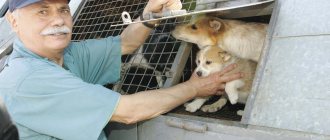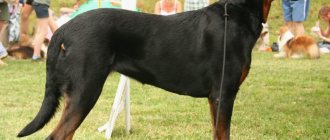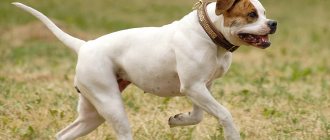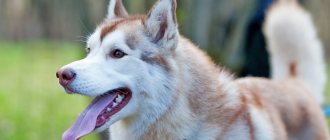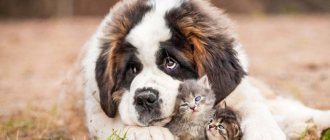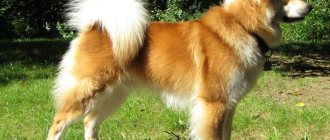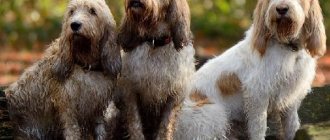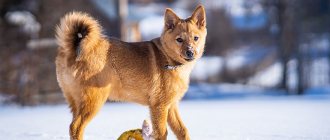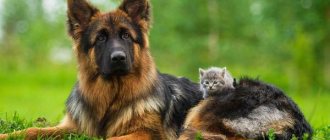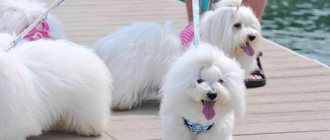13 May42184family of canidspredatordingo
Dingo is a secondarily feral domestic dog, a representative of the Canidae family from the genus of wolves. The dingo is one of Australia's most famous animals. The dingo dog has a mysterious origin and is highly intelligent. In this article you can see photos and descriptions of dingoes and learn a lot of new and interesting things about the life of this wild dog of Australia.
What does a dingo look like?
Dingo looks like an ordinary dog with a good constitution. But a wide head, erect ears, a fluffy long tail and large fangs distinguish the dingo animal from an ordinary dog. The physique of this wild dog of Australia resembles a hound, so the dingo looks very athletic.
The dingo appears to be a robust, medium-sized dog. The height at the withers of the Australian dingo varies between 50-70 cm, with a weight from 10 to 25 kg. The length of the body, including the head, is from 90 to 120 cm, and the length of the tail is 25-40 cm. Females are smaller than males. The Australian dingo looks much larger than the Asian one.
Dingo looks quite fluffy, because its short fur is very thick. Usually the dingo dog has a red or reddish-brown color, but its muzzle and belly are always much lighter.
Occasionally, almost black, white or spotted dingoes can be seen. In addition, the dingo animal often interbreeds with domestic dogs, but such individuals are considered hybrids. In addition, purebred individuals cannot bark, but can only howl and growl like a wolf.
Features and habitat of the dingo dog
Today, representatives of the dingo breed can be found virtually throughout Australia, as well as in Thailand, the Philippines, Laos, Indonesia, Myanmar, Malaysia, and the islands of Borneo and New Guinea.
The dingo dog is one of the main predators of the Australian islands
The body length of the animal usually does not exceed one hundred and twenty centimeters; the height of the dingo ranges from 50 to 55 centimeters. The tail is medium in size, its length is usually from 24 to 40 centimeters.
The weight of dingoes varies from 8 to 20 kg, with males being significantly larger and heavier than females. Scientists have repeatedly noted that representatives of dingo dogs living on the territory of modern Australia are much larger than their counterparts from Asian countries.
The dingo's coat is thick and short. The fur is usually red in color with various shades. The muzzle and belly are somewhat lighter than the rest of the color; on the back, on the contrary, there are the darkest places.
There are varieties of the wild dingo dog that are black in color, which, according to some scientists, was the result of crossing with the German shepherd.
Where does the dingo live?
The dingo dog lives in Australia; it is widespread throughout almost the entire continent. The largest numbers of these animals are found in the northern, western and central parts of Australia. The dingo dog also lives in small quantities in Southeast Asia (Thailand, Myanmar, Philippines, Laos, Borneo, Indonesia, Southeast China, Malaysia and New Guinea).
The dingo is an Australian animal that is predominantly nocturnal. In Australia, the dingo lives mainly in eucalyptus thickets, semi-deserts and forests. The dingo dog lives in a den, which it usually makes in a cave, tree roots, empty holes, and most often not far from a pond. In Asia, the dingo lives close to humans, as it feeds on waste.
History of the dingo breed
According to historical research, the dingo is one of the most ancient breeds. The history of the dingo breed began in Southeast Asia 4,000 years ago, from where they migrated to Australia along with settlers. They got their name from the Australian Aborigines, who called the dogs “tingo”. Domesticated predators were abandoned by their owners after some time (perhaps due to their complex, quarrelsome nature) and returned to the wild.
For many years, the animal was considered an enemy of livestock farmers, as it attacked herds and destroyed livestock. Attempts to tame the dingo again were unsuccessful. To protect rabbits, sheep and other domestic animals, a huge wall with a length of about 1000 km was built across the entire continent. It separated the habitat of Australian dogs from the lands that became the center of livestock development.
Today there are very few people who want to buy such a pet. Breeders of these dogs value them, first of all, for their excellent watchdog qualities.
What does a dingo eat and how does a dingo dog live?
The dingo feeds primarily on small mammals, including rabbits, but also preys on kangaroos and wallabies. In addition, the dingo feeds on birds, reptiles, insects and carrion. When mass cattle breeding began on the mainland, Australia's wild dog began to attack it.
Dingo raids on livestock caused farmers to begin exterminating dingoes. In Asia, dingoes feed on various food scraps. The Asian dingo also feeds on snakes, lizards and rats. By the way, in Asia people eat dingo meat.
The dingo dog most often lives alone, with the exception of the mating season. However, dingoes can gather in groups to hunt large prey. Typically, a dingo pack consists of 3-12 individuals, controlled by a dominant pair. The laws of a dingo pack are the same as those of wolves - a strict hierarchy is observed in the pack. Each flock has its own hunting area, which it carefully guards.
Dingo has excellent eyesight and hearing, and the dingo animal is very smart, dexterous and quick-witted. The most important character trait of dingoes is extreme caution, which helps them successfully avoid traps and poisoned baits. Only jackals compete with this dog of Australia. The enemies of adult dingoes are crocodiles; for young dingoes they are pythons, monitor lizards and large birds of prey.
Dingo photo
Add "WOOF!" 1
Breed characteristics: | |
| Type |
|
| Size | medium (11-25kg) |
| Main features |
|
| Intelligence | 55% |
| Price for dingo puppies Reviews All dog breeds | |
Dingo puppies
In a flock where dingoes live, only the dominant pair can produce offspring. When another female breeds pups, the dominant female kills them. All members of the pack take care of the cubs of the main pair. This Australian dog breeds puppies once a year. The dingo animal is monogamous. For Australian dingoes, the mating season begins in March-April, for Asian dingoes it occurs in August-September.
The dingo animal becomes capable of breeding offspring at the age of 1-3 years. The duration of pregnancy for this Australian dog is 3 months. Typically, the Australian dingo dog gives birth to 6-8 dingo puppies. Once born, dingo puppies are blind and covered with fur. Both parents look after the babies.
At the age of 1 month, dingo puppies already leave the den and soon the female stops feeding with milk. By the age of 2 months, dingo puppies finally leave the den and live with adults. Up to 3 months, the mother and other members of the pack help feed the puppies and bring them prey. By 4 months, dingo puppies are already independent and go hunting together with adults. In the wild, the dingo dog lives up to 10 years, in captivity up to 13 years.
In the wild, dingoes and domestic dogs often interbreed, so hybrids predominate in the wild. The only exceptions are those dingoes that live in protected areas in Australian national parks. Hybrids formed from crossing Australian dingoes and domestic dogs pose a greater threat as they are more aggressive. In addition, non-purebred dingoes breed 2 times a year, in contrast to purebred dingoes, in which breeding occurs once a year.
Dingo in the wild
In the wild, dingoes (see photo above) live in caves, burrows or thickets, near bodies of water. Young dogs stay apart, adults hunt in packs of 5 to 7 dogs. They feed on small mammals, such as rodents, rabbits, birds, and carrion. They often attack livestock.
These animals are distinguished by their intelligence and intelligence, thanks to which they survive in dangerous situations. Purebred individuals do not attack humans. Enemies of dingoes include dogs, jackals and birds of prey.
Closest relatives: New Guinea Singing Dog and Finnish Spitz.
The history of the dingo dog
There are many versions and legends surrounding the origin of the dingo dog breed. Some argue that the dingo animal was brought to Australia by immigrants from Asia. Others believe that the wild dingo dog evolved from domestic Chinese dogs. And according to others, it is said that the Australian dingo is a descendant of Indian wolves. We also know the animal dingo from the story by R. Fraerman, entitled “The Wild Dog Dingo, or the Tale of First Love,” which was written in 1939.
The history of the dingo dog is full of mysteries and secrets. The most common version of the origin of the dingo dog breed is considered to be the one in which it was brought from Asia. The dingo dog was brought to the mainland in boats by fishermen who sailed from Asia more than 5 thousand years ago. The dingo dog breed spread very quickly and became a faithful assistant for the aborigines of Australia. Dingo dogs guarded a person's home and helped him hunt. However, over time, people abandoned their faithful dogs, and then they went wild.
When the owners abandoned the dingoes, they had no choice but to develop the territory of the mainland. The conditions for independent living turned out to be very favorable. Dingoes soon spread throughout the entire continent, including the adjacent islands. This dog of Australia is the mainland's main mammalian predator and plays an important role in the ecology of the continent. Australian dingoes regulate the continent's herbivores and rabbit populations.
In the 19th century, Australia began to actively develop sheep farming. Since dingoes hunted sheep and caused damage to the farm, they began to be shot, poisoned and caught in traps. But already in the 1880s, in order to fence off areas of sheep pastures and protect livestock from dingoes, the construction of a “dog fence” began. Later, individual sections of the fence were joined together to form a barrier that was only interrupted by the highway.
Now the fence is more than 5 km long and separates the arid part of Australia from the fertile one. The fence is maintained annually, and along it there are patrols that repair damage to the fence and destroy animals that have penetrated the fence.
It is believed that purebred dingoes do not attack people, but there are exceptions to any rule. Cases of an Australian dingo attacking a person are extremely rare. One such case in Australia in 1980 was the death of a nine-week-old girl who was dragged away by a dingo.
It is not customary to keep these dogs at home, and in some countries it is completely prohibited to keep dingoes as a pet. But some people still get these animals. They claim that the Australian dingo is an excellent and unpretentious dog that is loyal and gets along well with other dogs living in the house.
In captivity, the dingo animal does not take root well and often escapes, although some Australians manage to tame them. Of course, it is best to tame a dingo as a puppy; it is almost impossible to tame adults. It should always be remembered that this dog of Australia is primarily a wild predator and can be quite unpredictable.
If you liked this article and you like to read about animals, subscribe to site updates and be the first to receive the latest and most interesting news about the animal world.
Don't forget to share with your friends!
Dingo training
The dingo is not called a wild dog for nothing. It is very difficult to tame and raise an animal that is suspicious of humans. A difficult character and lack of loyalty are what the owner of this predator runs the risk of encountering.
Raising an animal should begin from puppyhood , taking the baby from its parents, when the dog is much more pliable. With proper patience, it can be tamed.
Dingo is a predator living in a pack where leadership is very pronounced. When taming a dog, it is necessary to put it in its place from a very early age. An adult cannot be trained , with extremely rare exceptions.
However, by taking a small puppy into your home and showing the proper patience, you can raise a good friend and family member . But it is important to remember that a predator always remains a wild animal, unpredictable and dangerous.
